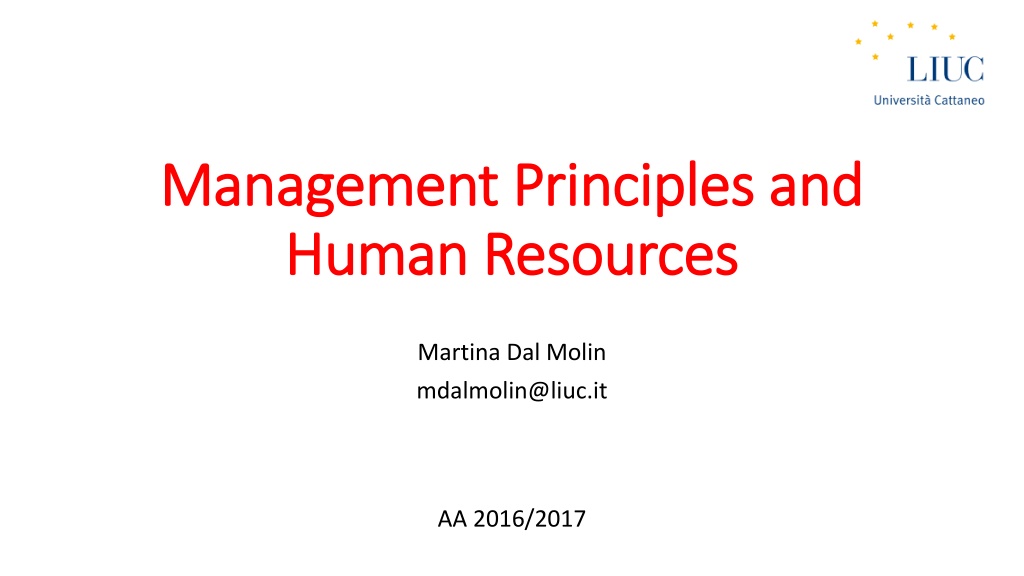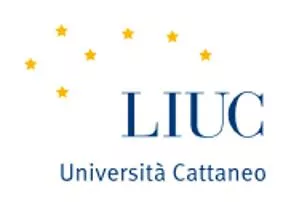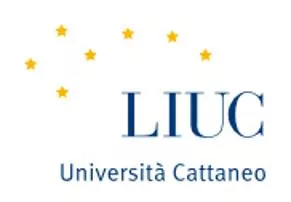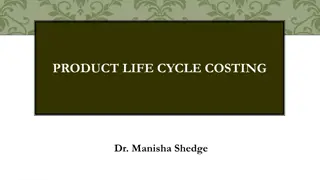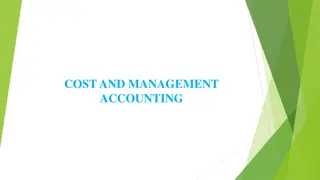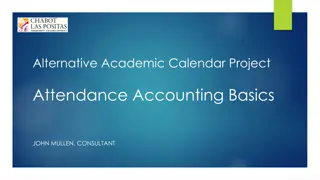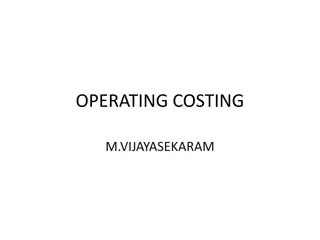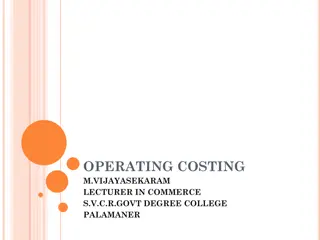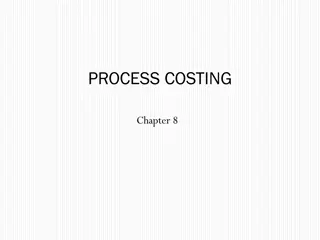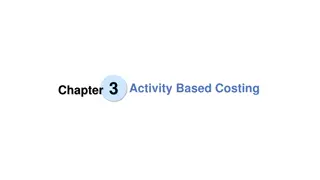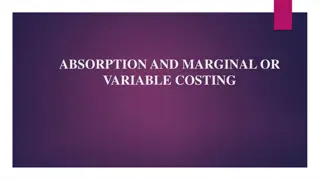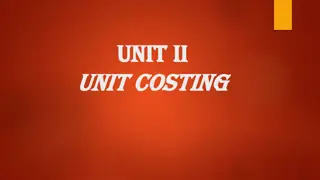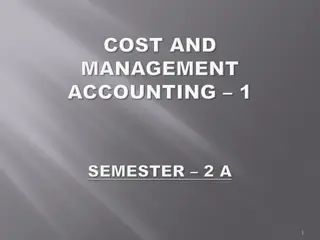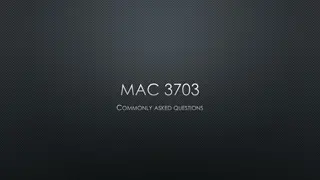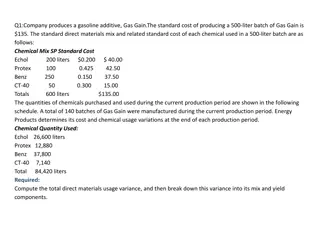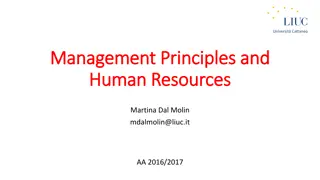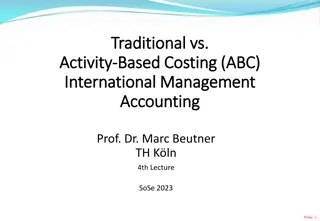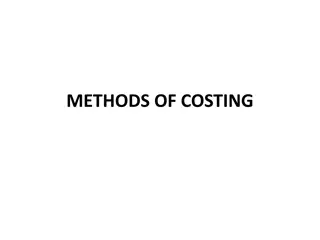Principles of Costing in Management Accounting
In this content, you will delve into the principles of costing in management accounting, covering cost concepts, typologies of costs, and costing techniques. Contrasting financial and management accounting, the focus shifts to understanding and allocating revenues and costs based on their destination in management accounting. Explore the objectives of management accounting, such as identifying inventory values, evaluating unit performance, and assessing goods profitability. Additionally, discover the distinctions between financial and management accounting in terms of stakeholders, decision-makers, historical perspectives, emphasis on verifiability vs. relevance, precision vs. timeliness, and reporting requirements.
Download Presentation

Please find below an Image/Link to download the presentation.
The content on the website is provided AS IS for your information and personal use only. It may not be sold, licensed, or shared on other websites without obtaining consent from the author.If you encounter any issues during the download, it is possible that the publisher has removed the file from their server.
You are allowed to download the files provided on this website for personal or commercial use, subject to the condition that they are used lawfully. All files are the property of their respective owners.
The content on the website is provided AS IS for your information and personal use only. It may not be sold, licensed, or shared on other websites without obtaining consent from the author.
E N D
Presentation Transcript
Management Management Principles Human Human Resources Principles and Resources and Martina Dal Molin mdalmolin@liuc.it AA 2016/2017
Agenda Agenda Introduction Cost concepts Typologies of costs Costing Techniques 2
INTRODUCTION INTRODUCTION
From Financial Accounting. From Financial Accounting . Financial Accounting focus on the whole company by providing synthetic information to stakeholders Information of financial accounting are too synthetic to support the company s decision-making process The company needs to understand which goods and units are responsible for the company s results 4
.to Management Accounting (1/2) .to Management Accounting (1/2) The company needs to understand which goods and units are responsible for the company s results Management Accounting Revenues and costs are allocated according to their destination When a resource is consumed, the management accounting identifies the related cost that is linked to the unit or the good that actually consumed that resource 5
.to Management Accounting (2/2) .to Management Accounting (2/2) Revenues and costs are allocated according to their destination It is possible to achieve three different objectives: oTo identify the correct value of inventories (wip and finished goods) oTo evaluate the performance of an organizational unit oTo evaluate the degree of goods profitability 6
Financial and Management Accounting Financial and Management Accounting Financial Accounting Management Accounting External persons who make final decisions Managers who plan for and control an organization Users Time and focus Historical perspective Future emphasis Verifiability vs relevance Emphasis on verifiability and objectivity Emphasis on relevance Precision versus timeliness Emphasis on precision Emphasis on timeliness Subject Company wide report Products reports Any rules or law to prescribe a format Rules Specific rules (e. g. IAS) Requirement Mandatory for external reports Not mandatory 7
COST CONCEPTS COST CONCEPTS
Manufacturing Manufacturing costs costs Direct labor Overhead Direct materials The product 9
Direct Direct materials materials Raw materials that become an integral part of the product and that can be conveniently traced directly to it. 10
Direct Direct labor labor Those labor costs that can be easily traced to individual units of product 11
Overhead Overhead Manufacturing costs that cannot be easily traced directly to specific units produced INDIRECT LABOR INDIRECT MATERIALS Materials used to support the production process. Examples: lubricants and cleaning supplies used in the automobile assembly plant Wages paid to employees who are not directly involved in production work. Examples: maintenance workers, janitors, and security guards. 12
Non manufacturing Non manufacturing costs costs ADMINISTRATIVE COSTS SELLING COSTS Costs necessary to secure the order and deliver the product. All executive, organizational, and clerical costs. 13
TYPOLOGIES of COSTS TYPOLOGIES of COSTS
Cost Cost and and revenues revenues by by destination destination Management Accounting classifies costs and revenues following their destination Revenue related to a good is identifiable through a specific and tangible document, i.e. the invoice For costs much more subjectivity exists 15
The The problem problem of of costs costs (1/2) (1/2) Should we or should we not consider the salary of Mr. Stadler for the development of a car? 16
The The problem problem of of costs costs (2/2) (2/2) To a same object of cost is it possible to associate different cost configurations To understand the different cost configurations, we need to analyze the different typologies (or categorization) of costs: PRODUCT COST vs PERIOD COSTS VARIABLE COST vs FIXED COSTS HISTORICAL COST vs STANDARD COSTS AVOIDABLE COST vs NOT AVOIDABLE COSTS (decision-making) 17
Product Product costs costs vs vs period period costs costs PRODUCT COSTS They represent the value of resources used for the realization of a specific product / service, for the physical transformation of the input in output Direct labor, direct material, manufacturing overhead PERIOD COSTS They represent the value of resources used in activities not associated with the making of a product / service according to a causal link (i.e. not directly related to processing operations in physical input output), but necessary for the functioning of the company in whole R&D, selling costs and administrative costs, general expendes 18
Product Product costs costs vs vs period period costs costs: : quick quick check check Which of the following costs would be considered a period rather than a product cost in a manufacturing company? A. Manufacturing equipment depreciation. B. Property taxes on corporate headquarters. C. Direct materials costs. D. Electrical costs to light the production facility. E. Sales commissions. 19
Variable Variable costs costs vs vs fixed fixed costs costs (1/2) (1/2) FIXED COSTS Total fixed cost is not affected by changes in the activity level within a relevant period of time VARIABLE COSTS Total variable cost Increase to changes in the activity level A cost is variable if it varies proportionately to variation of the productive volume 20
Variable Variable costs costs vs vs fixed fixed costs costs (1/2) (1/2) VARIABLE COSTS FIXED COST Monthly fee per phone calls Cost per text sent N. Of text sent N of phone calla 21
Fixed Fixed costs costs vs vs variable variable costs costs: : quick quick check check Which of the following costs would be variable with respect to the number of cones sold at an ice-cream parlor? (There may be more than one correct answer.) A. The cost of lighting the store. B. The wages of the store manager. C. The cost of ice cream. D. The cost of napkins for customers. 22
Period Period- -product product costs costs and and fixes fixes- -variable variable costs costs Direct Materials Direct Labor Energy Vendors commissions Selling costs VARIABLE COSTS Depreciation Cost of rent (production) Indirect labor Maintenance General and Administrative costs Costs of R&D Advertising and promotion FIXED COSTS PERIOD COSTS PRODUCT COSTS 23
Historical Historical costs costs vs standard vs standard costs costs HISTORICAL COSTS Historical cost are the cost accounted ex post, at the end of the period STANDARD COSTS Standard costs are the theoretical cost (i.e. defined ex ante) defined following specific information, that represent the point of reference for the analysis of deviations For the definition of standard costs, extraordinary events are not considered (indeed they are defined ex ante) 24
S Standard tandard costs costs DIRECT MATERIALS Cstd = Qstd *Pstd DIRECT LABOR Cstd= Tstd*Pstd OVERHEAD OVHstd= K*LDstd K= OVHstd Tot/LDstd tot 25
Avoidable Avoidable costs costs vs vs not not avoidable avoidable costs costs AVOIDABLE COSTS Avoidable cost depend on the decision Typically, direct materials, direct labor (in specific contractual situation) NOT AVOIDABLE COSTS Not avoidable cost do not depend on the decision Typically: fixed overhead 26
COSTING TECHNIQUES COSTING TECHNIQUES
System to System to collect It refers to the system of rules through which management accounting allocates the overall costs to the single organizational units or to specific products (i.e. the example of Mr. Stadler) collect and to allocate and to allocate costs costs ORGANIZATIONAL UNITS PRODUCTS RESOURCES Set of resources linked to a product Valorization Costs turnover Allocation of costs 28
EBITA in Management Accounting EBITA in Management Accounting EBITA To calculate a company's EBITA, start with its earnings before tax (EBT), which can be found on the income statement, and add interest and amortization expenses back in. EBITA = earnings before tax (EBT) + interest expense + amortization expense We don t have specific rules that define how to calculate (i.e. which costs have to be considered) to calculate the EBITA. Is it therefore possible to identify different models to calculate the EBITA The choice of one model depends on the goal(s) of the analysis 29
Rules Rules to allocate to allocate costs costs Direct Costing We allocate only the costs that are directly consumed by the product (in general, direct labor and direct materials) Reduction of mistakes for the allocation of costs Full Costing We allocate the costs that are directly consumed by the product (in general, direct labor and direct materials) We allocate also indirect costs, and the allocation modality depends on the criteria we use to allocate costs It clarifies that indirect activities are not costless , but they affect the overall profitability of the company 30
Costing Costing Techniques Techniques Costing techniques: Job order costing Process costing Operation Costing Activity Based Costing Costing Techniques Direct Material Direct Labor Overhead Process Costing Proportional Proportional Proportional Operation Costing Causal Proportional Proportional Job order costing Causal Causal Proportional Activity Based Costing Causal Causal Causal 31
